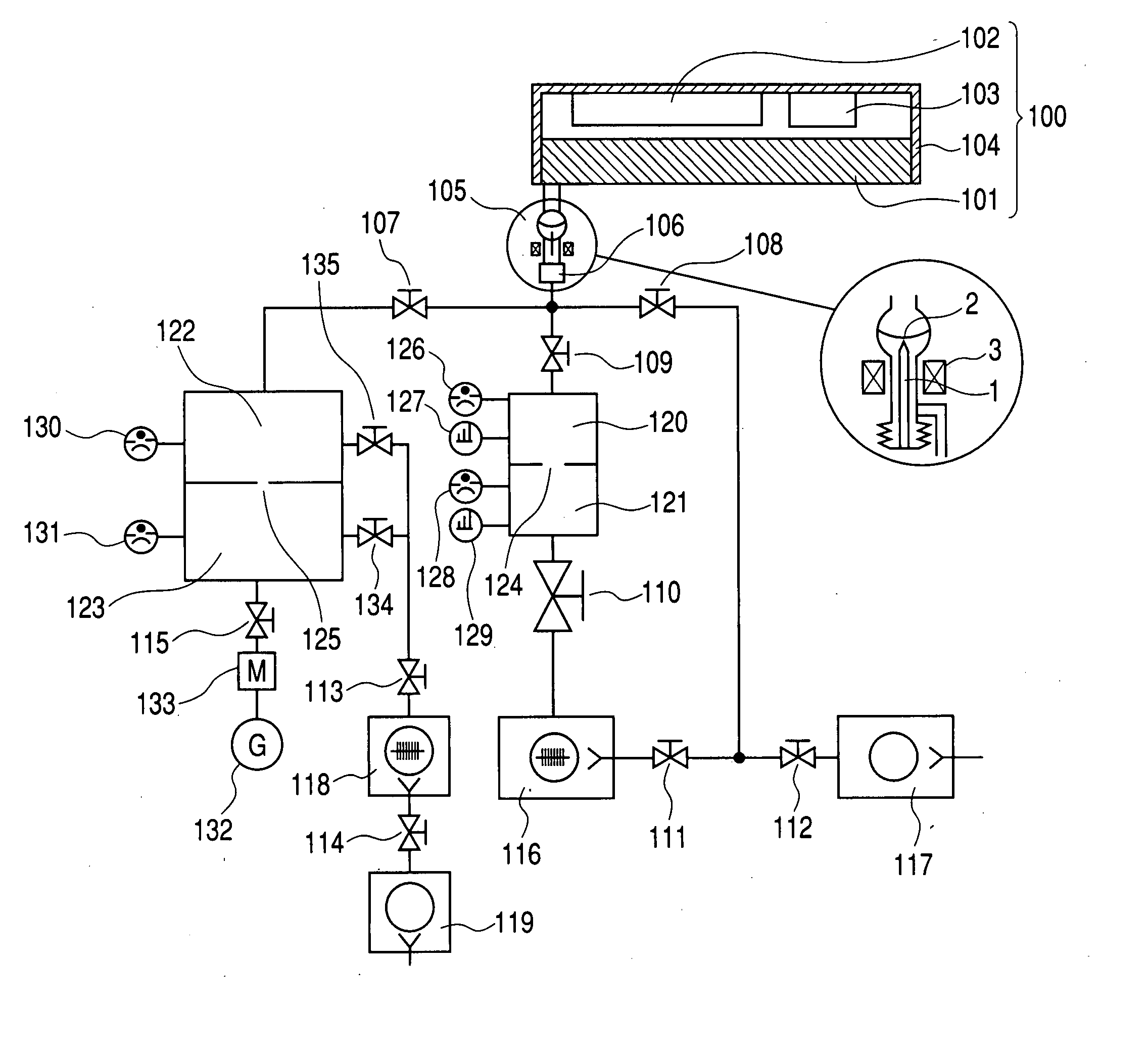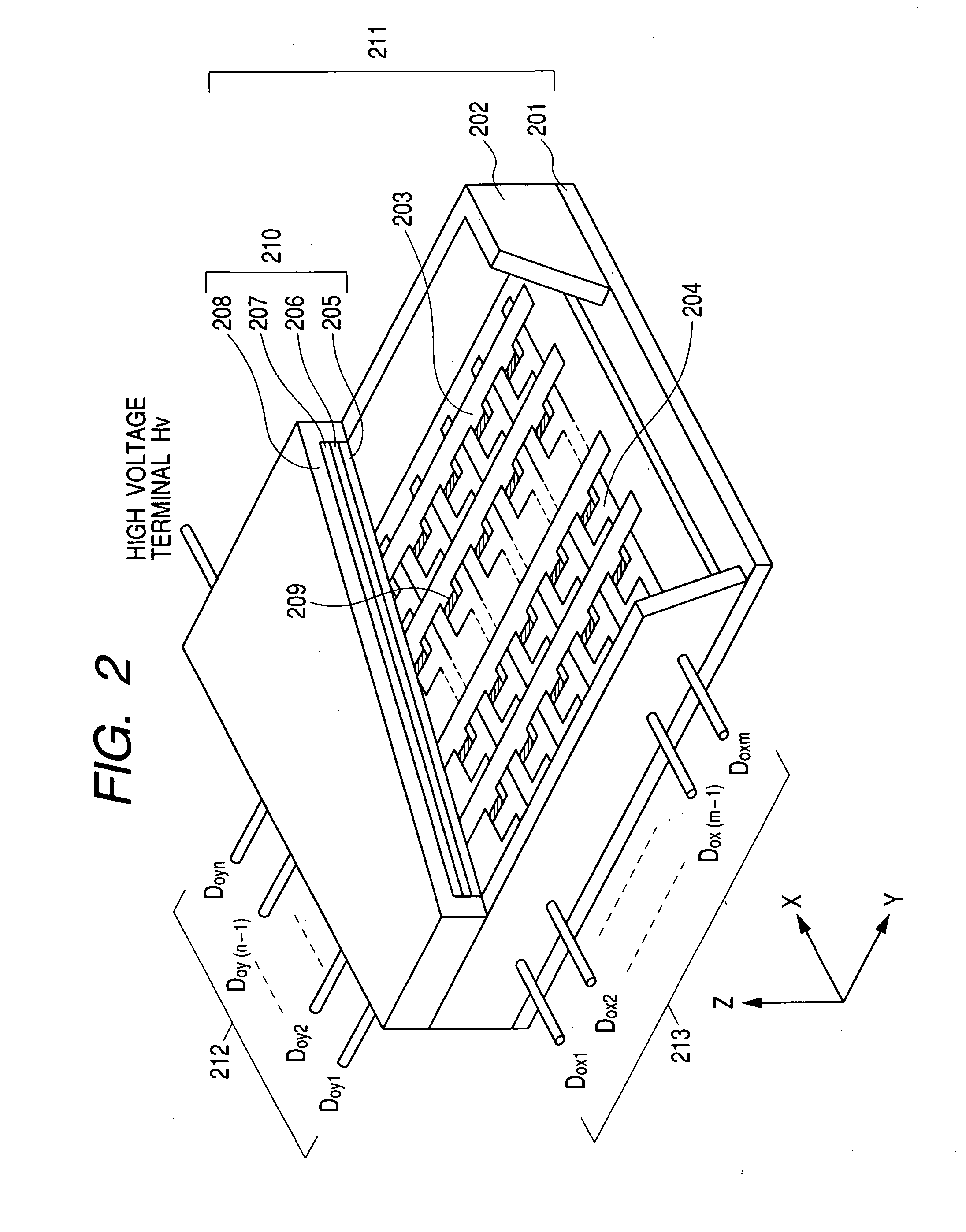Sealed container, manufacturing method therefor, gas measuring method, and gas measuring apparatus
- Summary
- Abstract
- Description
- Claims
- Application Information
AI Technical Summary
Benefits of technology
Problems solved by technology
Method used
Image
Examples
example 1
Referring to FIG. 8, the gas measuring method using the measuring apparatus for the image display device is described. Also, referring to FIGS. 2 to 7, a method of manufacturing the sealed container as the image display device that has undergone the gas measurement is described.
First, description will be made of the method of manufacturing the sealed container as the image display device. As the rear plate 201, soda glass (SL; manufactured by Nippon Sheet Glass Co., Ltd.) having a thickness of 2.8 mm and a size of 240 mm×320 mm was used. As the face plate 210, soda glass (SL; manufactured by Nippon Sheet Glass Co., Ltd.) having a thickness of 2.8 mm and a size of 190 mm×270 mm was used.
As the device electrodes 401 and 403 of the surface conduction electron-emitting device 209 as the electron source, a platinum film was formed on the rear plate 201 by the evaporation method, and processed by the photolithography technique (including processing techniques such as etching and lift...
example 2
In Example 2, the image display devices to be the sample and the product were manufactured in the same manner as in Example 1 except that 10 lines of devices (6000 devices) were formed, as shown in FIG. 7, using a mask made of SUS when Ba evaporation was performed to the region in which the Ba getter film 205 was not formed. Then, the sample was used to perform the gas measurement.
From the voltage applying device 102, an image signal of 167 μsec, 60 Hz, and 15 V was supplied to electron-emitting devices in a single line (600 devices) in a region in which the Ba getter film 205 was not formed. At the same time, a high voltage of 10 KV was applied to the electron-emitting devices by the high-voltage applying device 103 to cause the surface conduction electron-emitting device 209 to emit light. Thus, an image was displayed in the image display device 100. The emission gas rate of CO was measured similarly to Example 1.
When the emission gas rate of CO at the time of initial image d...
example 3
In Example 3, an Ar gas instead of CO was introduced to the apparatus in the same manner as in Example 2 except that the image display panel 101 was the same as that of Example 1. The purity of the Ar gas to be used was 99.9999%. Before introducing the Ar gas, the valve 110 was closed and the valve 109 was opened. When the pressure of the first ionization vacuum gauge 126 became 10−6 Pa, the valve 107 was closed. When the partial pressure of the gas was measured by the first mass spectrometer 127, the main gas was Ar, and the partial pressure of Ar was approximately 10−6 Pa. The background before this measurement, that is, before the Ar gas was introduced had been 2.5×10−11 Pa.
Next, an image was displayed in the image display device 100 under the same conditions as in Example 1. The initial current value was 10 μA per unit device, and a measurement was performed as to how much current is maintained comparing with the current value after 24 hours. The similar measurement was perfo...
PUM
 Login to View More
Login to View More Abstract
Description
Claims
Application Information
 Login to View More
Login to View More - R&D
- Intellectual Property
- Life Sciences
- Materials
- Tech Scout
- Unparalleled Data Quality
- Higher Quality Content
- 60% Fewer Hallucinations
Browse by: Latest US Patents, China's latest patents, Technical Efficacy Thesaurus, Application Domain, Technology Topic, Popular Technical Reports.
© 2025 PatSnap. All rights reserved.Legal|Privacy policy|Modern Slavery Act Transparency Statement|Sitemap|About US| Contact US: help@patsnap.com



